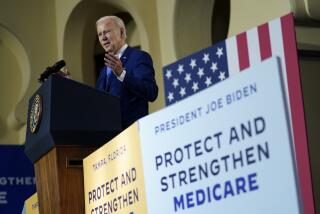Column: Here’s one key reform that can fix U.S. healthcare

- Share via
For more than 50 years, as the economics of American healthcare and health insurance have evolved, one theory has persisted, unchanged: To promote better and more efficient medical treatment, patients must have “skin in the game.”
The idea is that requiring fees for doctor or hospital visits — through co-pays, deductibles and other forms of cost-sharing — will prompt people to think twice before seeking treatment for anything but a truly serious condition.
“On the question of whether patients should have to pay part of the cost of their covered medical care, our profession’s advice has been unequivocal,” health economists Liran Einav of Stanford and Amy Finkelstein of MIT wrote in their 2023 book, “We’ve Got You Covered: Rebooting American Health Care.” “Patients must pay something for their care, otherwise they’ll rush to the doctor every time they sneeze.”
Among all advanced industrial countries, the U.S. goes furthest in using premiums, copays, and deductibles to influence access to care.
— Merrill Goozner, STAT
Einav and Finkelstein own up to having “preached the gospel” of skin-in-the-game “to generations of students.”
Now here’s their punchline: “We take it back.”
To healthcare reformers such as single-payer advocates Adam Gaffney, David U. Himmelstein and Steffie Woolhandler, the confessional by Einav and Finkelstein “may signal an encouraging shift in elite opinion, at least among economists,” as they wrote recently in the New York Review of Books.
Get the latest from Michael Hiltzik
Commentary on economics and more from a Pulitzer Prize winner.
You may occasionally receive promotional content from the Los Angeles Times.
Others have begun to take notice. “Among all advanced industrial countries, the U.S. goes furthest in using premiums, copays, and deductibles to influence access to care,” the veteran healthcare journalist Merrill Goozner observes. “It is time to put an end to this failed experiment.”
Yet the imposition of financial obstacles to limit access to care still exerts a powerful influence on healthcare policy in the U.S. In part, this is because it makes sense, superficially. The mantra goes: “If you want less of something, tax it more.” So it has a built-in appeal to government budget hawks and corporate executives who want to reduce healthcare spending.
For some, there’s a moral component — why shouldn’t people take personal responsibility for their own health, whether by smoking and eating less or paying for healthcare partially out of their own pockets, even if they have to be forced to make treatment choices based partially on their out-of-pocket costs?
Water fluoridation revolutionized dentistry, especially for children. Why does the right wing think it’s a problem?
Then there’s the empirical evidence: It’s true that the higher the co-pays and deductibles, the less medical care people seek, on average.
The seminal study on this topic was Rand’s Health Insurance Experiment, reported in 1981. Starting in 1971, Rand recruited 2,750 families — 7,700 individuals — slotted randomly into five groups: One was offered free care, three groups were offered different levels of cost-sharing, and the fifth was placed in a nonprofit HMO.
Rand found that the groups with cost-sharing made one or two fewer physician visits a year and had 20% fewer hospitalizations than the group with free care. Their dental visits, prescriptions and mental health treatments were also lower. Unsurprisingly, they spent less on healthcare.
The initial findings seemed to validate the skin-in-the-game theory. As Rand continued reporting out the results over the next few years, however, air began to leak out of the balloon.
It became clear that although the cost-sharing subjects cut back on ineffective or unnecessary care, they also cut back on effective and necessary treatments. The reduced utilizations, Rand found, occurred because the subjects decided to delay or forgo treatments, possibly inadvisedly. Once they initiated care, the effect of cost-sharing dropped away, as the patients ceded their decision-making to their healthcare providers.
Some decisions weren’t affected at all by cost-sharing. “The proportion of inappropriate hospitalizations was the same (23 percent) for cost-sharing and free-plan participants, as was the inappropriate use of antibiotics,” Rand reported. Nor did cost-sharing prompt subjects to seek out higher-quality care; the general quality of outpatient and dental care was “surprisingly low for all participants.”
Putting enemies of science in charge of science policy is a formula for mass injury and death, history reminds us.
Although Rand found “no adverse effect on participants’ health” from the reduction in services prompted by cost-sharing, the free plan led to better healthcare for plan members in four categories: improved control of hypertension, better vision care, better dental care for the poorest patients, and fewer serious health symptoms for the poorer patients, including less chest pain when exercising and fewer episodes of loss of consciousness.
Once cost-sharing became a standard element of American health insurance, Gaffney, Himmelstein and Woolhandler write, “the consequences were dire.”
The Heritage Foundation developed a model combining extreme deductibles and tax-advantaged savings accounts to pay the out-of-pocket expenses, which Heritage argued would “transform patients into prudent consumers.” The high-deductible/health savings account model was enacted into law, but plainly has failed to create an army of prudently cost-sensitive patients.
Co-pays and deductibles became permanently etched into employer-sponsored health plans. When the initial Rand findings were published, report Gaffney, Himmelstein and Woolhandler, only 30% of private health plans had a deductible for hospital stays; today 90% of workers with employer plans have annual deductibles averaging $1,735 per participant. Conservative governors and legislatures have tried to impose cost-sharing fees on patients in Medicaid, the nation’s healthcare program for low-income households.
And, of course, the cost-sharing revolution has utterly failed to control U.S. healthcare costs or bring about a healthier nation. Per capita healthcare spending in the U.S. has risen from about $350 in 1970 to $14, 470 in 2023. In inflation-adjusted terms, it has increased nearly sevenfold.
As for health outcomes, of 13 wealthy countries tracked by the Peter G. Peterson Foundation, the U.S. spends the most per capita by a wide margin and scrapes the bottom of the barrel on outcomes — the worst average life expectancy, worst infant mortality rate, worst rate of unmanaged diabetes, worst maternal mortality and nearly the worst heart attack mortality.
The Trump campaign is promoting a healthcare solution that was tried and shown to be a failure. It would place people with preexisting conditions at mortal risk.
Obviously, the American healthcare system has many flaws other than its reliance on cost-sharing. But all its flaws are related in some way to its economic structure, which has produced legions of uninsured and underinsured people, as well as crushing medical debt for millions. (On Tuesday, the Consumer Financial Protection Bureau made final a rule requiring medical debts to be removed from consumers’ credit reports. But the debts still remain.)
In recent years, the U.S. has started to get its arms around the uninsured crisis. That’s largely due to the 2010 Affordable Care Act, which has brought access to Medicaid and subsidized health plans for about 42.5 million people. The uninsured rate fell from nearly 18% (or 46.5 million people) in 2010 to 9.5% (25.3 million) in 2023.
Can these gains be advanced and sustained? The incoming Trump administration doesn’t present grounds for optimism. In his first term, Donald Trump and his acolytes worked tirelessly to undermine the ACA and Medicaid. The number of uninsured rose to 28.9 million in 2019 from 26.7 million in 2016.
It would surprise no one if the new administration takes a hands-off approach to the increasing corporatization of healthcare, including the takeover of hospitals and nursing homes by penny-pinching private equity firms and the pushing of more Medicare enrollees to join private Medicare Advantage plans, which have become known for costing the government more than traditional Medicare, and for profit-seeking through claim denials.
Still, it’s the installation of cost-sharing as a medical management tool that harms people day in and day out. That the tool has never fulfilled its promise doesn’t seem to faze policymakers. On the surface, after all, it should work, shouldn’t it?
More to Read
Get the latest from Michael Hiltzik
Commentary on economics and more from a Pulitzer Prize winner.
You may occasionally receive promotional content from the Los Angeles Times.














